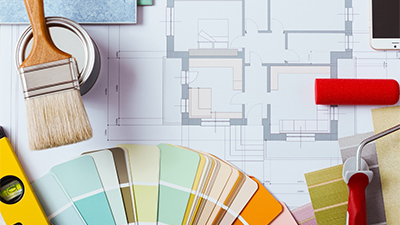Choosing a colour for a just one room can be tricky enough, so for many, the idea of picking a colour palette for the whole of a major home renovation can seem like an overwhelming task. Whether it’s for interiors or the exteriors, adding a well-thought out colour scheme to a remodelled house can help create a home that reflects your personal tastes and achieves the look and feel you want for a space. Here are Keystone’s 5 tips for adopting colour to add the ‘wow’ factor to your house makeover.
COMPLEMENT THE ARCHITECTURE OF THE HOUSE
The first step to selecting the right colours for your house is understanding the architecture of your home. This requires an appreciation of how the renovations will change the composition of your house. You should be asking which spaces will you be able to see from each room and down hallways as this will form the basis of your whole-house colour plan.
The largest room of your new floor layout will set the tone for the rest of the house, so be careful to workshop your colour choices to test what type of statement you are wanting to make. You don’t have to choose Mediterranean colours like reds and oranges to make a style statement, choosing a dusky blue can reflect a confident personality equally as well along with giving greater highlight potential for a room’s other features like ceilings and floors. If you like to play it safe, white or off white suits all architectural types, although of course practical consideration is required if you have small children that are prone to touching walls.
UNDERSTAND HOW THE COLOUR WHEEL WORKS
So that you are not stuck by indecision, using a colour wheel is a great tool in helping you figure out which colours will complement each other. The colour wheel also gives you such a variety of hues so you are not missing out on unique combinations that will give your home an individual touch.
Comprised of 12 different hues where one half comprises “cool” colours and the second half are “warm” colours, the colour wheel can help you explore possible paint schemes that can bring out the features of a room. With different shades, tints and tones, you’ll face no shortage of colour choices to consider for both the main walls and in helping you to bring accents to window sills and cornices to create interest and energy in a room.
EVERY ASPECT OF A ROOM COUNTS
When people think of painting their house, most immediately think of the colours for walls – however, considering all elements to a room will help in achieving a complete and long-lasting look. Almost anything in a room can welcome a coat of paint, even existing floorboards. If you live near a beach, or want to create a “beachy” feel, then it’s not out of place to paint floorboards white to help recreate a light and airy space, complementing the natural sea breeze.
Feature ceilings are also a possibility; if you’re extra daring, why not consider a colour other than white to create a point of interest. Keep in mind when choosing your ceiling colour as lighter ceiling shades to walls work better if you want your ceilings to appear higher than they are. But don’t feel like you have to change something that’s worked for years – a white ceiling can also offset an intense wall colour if you decide include a bold feature wall to add sharpness to a room.
IF IN DOUBT, STICK TO A NEUTRAL PALETTE
Extreme colour combinations can be off-putting to future buyers so consider how long you want to live in the property before you start experimenting with unique colour choices. Selecting neutral colours doesn’t have to limit your creative flair- vibrancy can be added to a neutral palette without negatively affecting the resale value of your home. This means steering away from using only one shade as selecting two or more neutral colours creates personality and avoids appearing dull.
Classic neutral tones for the interiors can create a soft and muted space and even support a modern look. For something a little less bland, try washed out tones that have more greys and contrast these with alternative textures like floorboards or wooden beams to bring about balance to a room. By opting for a neutral palette you have the flexibility to choose a range of furniture pieces as almost any coloured furniture item can look great and energise a muted room.
LOOK AT ALL OPTIONS FOR EXTERIORS
Like interiors, the colours you select for your exteriors should be shaped by the architecture of the house. If you have a period home, choose traditional colours like Regency White and York Stone so that the walls don’t draw attention away from external embellishments like iron lacework and decorative front doors.
Working well with the streetscape, choosing neutral colours for a modern home’s exteriors can avoid any conflicts with neighbours. There are a huge range of hues within a neutral palette that give you the flexibility to pick the colour that’s just right for your home. Why not also consider a tone-to-tone scheme to create a modern and contemporary exterior, where charcoal walls and white for trims like balconies can give a sophisticated and timeless look.
At Keystone, we walk with you through the journey of remodelling your home, we can recommend the right colour consultant to assist you with your colour decisions for your interiors and exteriors so there are no regrets with the finished product. Get in touch with us today to find out more.

